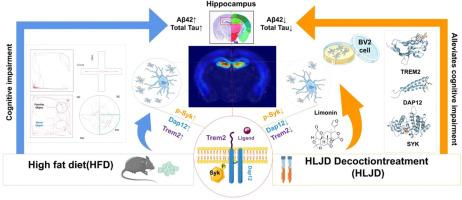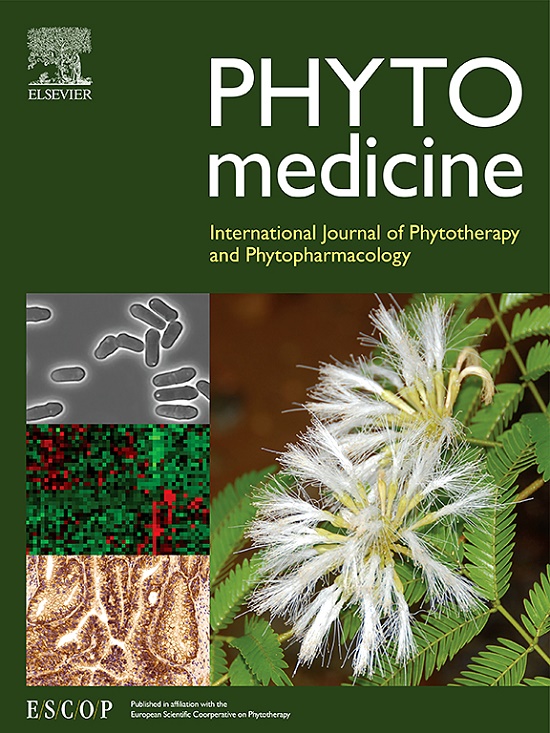Huang-Lian-Jie-Du decoction alleviates cognitive impairment in high-fat diet-induced obese mice via Trem2/Dap12/Syk pathway
IF 6.7
1区 医学
Q1 CHEMISTRY, MEDICINAL
引用次数: 0
Abstract
Background
Cognitive impairment induced by a high-fat diet (HFD) is common, but its mechanism is largely unknown. Huang-Lian-Jie-Du (HLJD) decoction is a classical and powerful prescription in China. It consists of four medicinal plants and is widely used in traditional Chinese medicines (TCM). Studies have shown that HLJD decoction is effective in treating obesity, depression, and so on. However, the therapeutic mechanism of HLJD is still poorly understood.
Purpose
Our study aimed to explore whether inflammatory factors and Trem2/Dap12/Syk pathway are involved in this process and whether HLJD treatment can repair cognitive impairment in HFD-induced obesity.
Methods
To obtain the obese mice, male mice were treated with HFD (60 Kcal% fat) for 16 weeks. After an additional eight weeks, HLJD decoction was administered orally at doses of 4 and 8 g/kg daily for eight weeks. The mice were then subjected to four behavior tests. Aβ42, total Tau, inflammatory-related, and microglial dysregulation-related markers expression were measured. Molecular docking analysis was also conducted to predict the interaction of the chemical constituents of HLJD with human TREM2, DAP12, and SYK. HLJD at doses of 12.5, 25, and 50 µg/mL or limonin at concentrations of 12.5, 25, and 50 µM were used to treat BV2 cells for 24 h. CCK8 assay and Trem2, Dap12, Syk, and p-Syk expression were measured.
Results
Our study revealed that cognitive impairment was evident in mice treated with HFD, indicating the impact of obesity on cognitive function. The expression of Aβ42 and total Tau in the hippocampus (HIP) was significantly higher in obese (HFD-V) mice compared to normal control (NC-V) mice. The Il6, Il1b, and Il10 mRNA expression levels were also markedly increased in the HIP of obese mice. Furthermore, Trem2, Dap12, p-Syk, and Iba1 expression were elevated in the HIP of obese mice. Importantly, HLJD treatment was found to repair cognitive impairment and lower the protein expression of Aβ42, Tau, Trem2, Dap12, p-Syk, and the expression of Il6, Il1b, and Il10 mRNA in HIP of HFD-V mice. The increased expression of Trem2, Dap12, p-Syk, and Iba1 in HIP after HFD consumption could be reduced after receiving HLJD decoction. The compound Limonin showed a well-predicted binding energy with TREM2, DAP12, and SYK. BV2 cells with HLJD or limonin detected the mRNA expressions of Trem2/Dap12. HLJD at 25 and 50 µg/mL decreased Trem2, Dap12, and p-Syk protein levels in BV2 cells.
Conclusion
These results reveal that HLJD treatment could alleviate cognitive impairment in HFD-induced obese mice by controlling the activation of the Trem2/Dap12 pathway and reducing Syk phosphorylation in HIP microglia. HLJD and limonin suppressed Trem2/Dap12/Syk signaling pathway in BV2 cells. HLJD therapy might represent a novel treatment for patients with cognitive impairment induced by obesity.

黄连解毒汤通过Trem2/Dap12/Syk途径缓解高脂饮食诱导的肥胖小鼠的认知障碍
背景高脂饮食(HFD)诱发的认知障碍很常见,但其机制尚不清楚。黄连解毒汤(HLJD)是中国的经典名方。它由四种药用植物组成,在传统中药(中医)中被广泛使用。研究表明,鸡血藤煎剂对治疗肥胖症、抑郁症等有显著疗效。目的 我们的研究旨在探讨炎症因子和 Trem2/Dap12/Syk 通路是否参与了这一过程,以及 HLJD 治疗是否能修复高密度脂蛋白胆固醇诱导的肥胖症认知障碍。再连续八周后,以每天每公斤 4 克和 8 克的剂量口服 HLJD 煎剂。然后对小鼠进行四项行为测试。测量了 Aβ42、总 Tau、炎症相关和小胶质细胞失调相关标记物的表达。还进行了分子对接分析,以预测 HLJD 的化学成分与人类 TREM2、DAP12 和 SYK 的相互作用。结果我们的研究发现,用高密度脂蛋白胆固醇(HFD)治疗的小鼠认知功能明显受损,这表明肥胖对认知功能有影响。与正常对照组(NC-V)小鼠相比,肥胖(HFD-V)小鼠海马(HIP)中 Aβ42 和总 Tau 的表达明显升高。肥胖小鼠 HIP 中的 Il6、Il1b 和 Il10 mRNA 表达水平也明显升高。此外,肥胖小鼠 HIP 中 Trem2、Dap12、p-Syk 和 Iba1 的表达也有所升高。重要的是,HLJD 治疗可修复认知障碍,并降低 Aβ42、Tau、Trem2、Dap12、p-Syk 的蛋白表达,以及 Il6、Il1b 和 Il10 mRNA 在 HFD-V 小鼠 HIP 中的表达。服用高纤维食物后,HLJD 水煎剂可降低 HIP 中 Trem2、Dap12、p-Syk 和 Iba1 的表达。化合物Limonin与TREM2、DAP12和SYK具有良好的结合能。用 HLJD 或柠檬素治疗的 BV2 细胞检测到了 TREM2/DAP12 的 mRNA 表达。这些结果表明,HLJD 治疗可通过控制 HIP 小胶质细胞中 Trem2/Dap12 通路的激活和减少 Syk 磷酸化来缓解高氟酸诱导的肥胖小鼠的认知障碍。HLJD和柠檬素抑制了BV2细胞中的Trem2/Dap12/Syk信号通路。HLJD疗法可能是治疗肥胖引起的认知障碍患者的一种新疗法。
本文章由计算机程序翻译,如有差异,请以英文原文为准。
求助全文
约1分钟内获得全文
求助全文
来源期刊

Phytomedicine
医学-药学
CiteScore
10.30
自引率
5.10%
发文量
670
审稿时长
91 days
期刊介绍:
Phytomedicine is a therapy-oriented journal that publishes innovative studies on the efficacy, safety, quality, and mechanisms of action of specified plant extracts, phytopharmaceuticals, and their isolated constituents. This includes clinical, pharmacological, pharmacokinetic, and toxicological studies of herbal medicinal products, preparations, and purified compounds with defined and consistent quality, ensuring reproducible pharmacological activity. Founded in 1994, Phytomedicine aims to focus and stimulate research in this field and establish internationally accepted scientific standards for pharmacological studies, proof of clinical efficacy, and safety of phytomedicines.
 求助内容:
求助内容: 应助结果提醒方式:
应助结果提醒方式:


